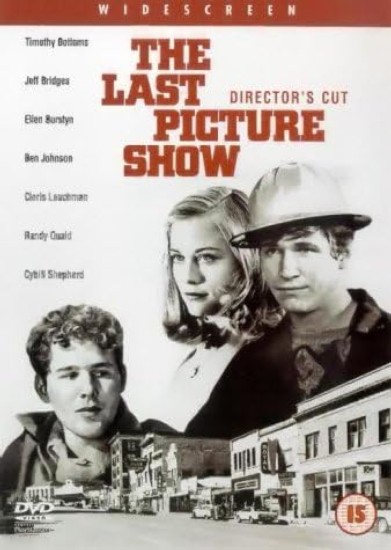The Last Picture Show
American coming-of-age drama set in small-town Texas in the early ‘50’s, Timothy Bottoms, Jeff Bridges and Cybill Shepherd play high school seniors whose lives revolve around football, the local movie theatre and a dead-end future.
Film Notes
There was something about going to the movies in the 1950s that will never be the same again. It was the decade of the last gasp of the great American movie-going habit, and before my eyes in the middle 1950s the Saturday kiddie matinee died a lingering death at the Princess Theater on Main Street in Urbana. For five or six years of my life (the years between when I was old enough to go alone, and when TV came to town) Saturday afternoon at the Princess was a descent into a dark magical cave that smelled of Jujubes, melted Dreamsicles, and Crisco in the popcorn machine. It was probably on one of those Saturday afternoons that I formed my first critical opinion, deciding vaguely that there was something about John Wayne that set him apart from ordinary cowboys. The Princess was jammed to the walls with kids every Saturday afternoon, as it had been for years, but then TV came to town and within a year the Princess was no longer an institution. It survived into the early 1960s and then closed, to be reborn a few years later as the Cinema. The metallic taste of that word, cinema, explains what happened when you put it alongside the name "Princess."
Peter Bogdanovich's "The Last Picture Show" uses the closing of another theater on another Main Street as a motif to frame a great many things that happened to America in the early 1950s. The theater is the Royal, and along with the pool hall and the all-night cafe it supplies what little excitement and community survives in a little West Texas crossroads named Anarene.
All three are owned by Sam the Lion, who is just about the only self-sufficient and self-satisfied man in town. The others are infected by a general malaise, and engage in sexual infidelities partly to remind themselves they are alive. There isn't much else to do in Anarene, no dreams worth dreaming, no new faces, not even a football team that can tackle worth a damn. The nourishing myth of the Western ("Wagon Master" and "Red River" are among the last offerings at the Royal) is being replaced by nervously hilarious TV programs out of the East, and defeated housewives are reassured they're part of the "Strike It Rich" audience with a heart of gold.
Against this background, we meet two high school seniors named Sonny and Duane, who are the co-captains of the shameful football squad. We learn next to nothing about their home lives, but we hardly notice the omission because their real lives are lived in a pickup truck and a used Mercury. That was the way it was in high school in the 1950s, and probably always will be: A car was a mobile refuge from adults, frustration, and boredom. When people in their thirties say today that sexual liberation is pale compared to a little prayerful groping in the front seat, they are onto something.
During the year of the film's action, the two boys more or less survive coming-of-age. They both fall in love with the school's only beauty, a calculating charmer named Jacy who twists every boy in town around her little finger before taking this skill away with her to Dallas. Sonny breaks up with his gum-chewing girlfriend and has an unresolved affair with the coach's wife, and Duane goes off to fight the Korean War. There are two deaths during the film's year, but no babies are born, and Bogdanovich's final pan shot along Main Street curiously seems to turn it from a real location (which it is) into a half-remembered backdrop from an old movie. "The Last Picture Show" is a great deal more complex than it might at first seem, and this shot suggests something of its buried structure. Every detail of clothing, behavior, background music, and decor is exactly right for 1951 -- but that still doesn't explain the movie's mystery.
Mike Nichols's "Carnal Knowledge" began with 1949, and yet felt modern. Bogdanovich has been infinitely more subtle in giving his film not only the decor of 1951, but the visual style of a movie that might have been shot in 1951. The montage of cutaway shots at the Christmas dance; the use of an insert of Sonny's foot on the accelerator; the lighting and black-and-white photography of real locations as if they were sets -- everything forms a stylistic whole that works. It isn't just a matter of putting in Jo Stafford and Hank Williams.
"The Last Picture Show" has been described as an evocation of the classic Hollywood narrative film. It is more than that; it is a belated entry in that age -- the best film of 1951, you might say. Using period songs and decor to create nostalgia is familiar enough, but to tunnel down to the visual level and get that right, too, and in a way that will affect audiences even if they aren't aware how, is one hell of a directing accomplishment. Movies create our dreams as well as reflect them, and when we lose the movies we lose the dreams. I wonder if Bogdanovich's film doesn't at last explain what it was that Pauline Kael, and a lot of the rest of us, lost at the movies.
Roger Ebert, Chicago Sun Times,
Notre Dame professor Edward Fischer has said that ‘the best films, like the best books, tell how it is to be human under certain circumstances’. Larry McMurtry did a beautiful job of this in his small novel (which he transferred to the screen), The Last Picture Show.
Timothy Bottoms and Jeff Bridges portray the pair of youths who complement each other’s limited potential. Physically, they’re much alike – football-playing, lanky, likable products of the Texas plains; mentally, or emotionally, they move on different planes. Bridges is the high school hero, more aggressive; Bottoms is the more sensitive, hence the more lonely, of the pair.
The boys grow a bit, some good people die, a few more secrets are revealed, and another ‘nothing’ decade has passed. Bridges, spurned by his girl, joins the army; Bottoms matures a bit. Not much else happens.
The best, most solid, most moving performances in the film are given by Ben Johnson, that old John Ford regular, as Sam The Lion, the owner of the picture show and pool room where the town boys spend most of their time; and Cloris Leachman as the football coach’s wife, who introduces Bottoms to sex.
Peter Bogdanovich elected to shoot the film in black and white, artistically appropriate for the dust-blown, tired little community, but Robert Surtees (who’s a master with color) doesn’t bring off the tones of gray. There is excellent use of many pop tunes of the period and only introduced in a natural manner – a nickel in a jukebox, a car radio, or an early television set.
Variety Staff, Variety magazine, Dec 31, 1970
Bogdanovich's perfect recreation of the sense of time and place, and his ability to mix wit with poignancy that make this such a charming, timeless film.
Sonny and Duane are best friends. Enduring that awkward period of life between boyhood and manhood, the two pass their time at the movie house, playing basketball, and chasing girls. The boys are torn between a future somewhere out there beyond the borders of town or making do with their inheritance of a run-down pool hall and their decrepit movie house, which faces closure.
Based on the novel by Larry McMurtry this is a more-bitter-than-bittersweet drama of growing up and winding down. Shot unusually in black and white while the rest of Hollywood was going psychedelic for 1971, it’s an interesting contrast with the rock ‘n’ roll nostalgia of American Graffiti, visiting a recent past already nostalgic for a heroic Western era and discovering that whatever was wonderful was already gone by the time of these teenagers.
Introspective Timothy Bottoms and outgoing Jeff Bridges are best friends, stalwarts of the school’s losing football team, and Cybill Shepherd the blonde teen queen who innocently spreads chaos everywhere, ditching longtime boyfriend Bridges to run with a richer, faster set, stealing Bottoms away from older married woman Cloris Leachman, and prompting a vicious falling-out between the fast friends. As the kids run around heedless, the town’s older generation remember their own wilder days and wonder how they came to be so unhappy:
Ben Johnson, in Academy Award-winning form, is the wise old cowboy who runs the movie house and pool hall, muses about his long-ago affair with Shepherd’s feisty mother (Ellen Burstyn). In essence, it’s a soap, but director Peter Bogdanovich plays it as a John Ford-style ‘closing of the frontier’ Western, with ugly-beautiful images of a West that has swapped cattle for oil but failed to strike it rich, layering in evocative snatches of Hank Williams among the whistling winds and the whining locals.
It perhaps has one tragedy too many in its last act, but delivers a signature line of wistful regret, ‘nothing’s been right since Sam the Lion died’. The director and cast reunited in 1990 to film McMurtry’s more farcical sequel Texasville.
Kim Newman, Empire Magazine,
What you thought about The Last Picture Show
Film Responses
| Excellent | Good | Average | Poor | Very Poor |
|---|---|---|---|---|
| 19 (36%) | 20 (38%) | 10 (19%) | 4 (8%) | 0 (0%) |
|
Total Number of Responses: 53 Film Score (0-5): 4.02 |
||||
Collated Response Comments
109 members and guests attended the screening of the Last Picture show.
We received 53 responses, which is a 49% response rate. Thank you so much. Many of you have commented on the lack of subtitles and the quality of the sound. Many apologies from all of us.
There was a technical problem in setting up the screening (a loose connection in the end) but no time for a proper rehearsal. The projectionists had clicked the subtitles button, but unfortunately the message did not transfer to the machine at the time of screening. Consideration was given to stopping nd starting again …. They decided to let it run.
All of your comments are collected below.
“I've watched 'The last picture show' several times before but not since the 1980s. It is interesting to me to note that it feels more bitter and less elegiac than when I watched it in my twenties. Sonny is weaker, especially in a group, Duane more foolish, Jacy more poisonous. In contrast Sam the Lion seems more resolute and Ruth braver. It still looks gorgeous, the black and white photography, redolent of Dorothea Lange's stills, is more eloquent than any colour could be. The supporting cast are stunningly good, Burstyn and Brennan in particular. The attention to detail is superb, the songs on the radio as scouring as the cold wind that seems to blow constantly. A heartfelt and honest love letter to, for better or worse, a vanished age. I'll give Tom Waits 'Burma Shave' another spin...”
“One of the best of the coming-of-age films ever; looked great on the big screen. A stone-cold classic which draws out raw emotions and a real feeling of life in an early 50's claustrophobic small town community hit by inevitable change; beautifully photographed by the film historian Bogdanovich in his second feature. A cry out to the past, when people enjoyed the experience of going out to a movie, instead of people nowadays squinting on a phone. The Sam the Lion speech by the pond was simple and but so poignant with the 'luck' of the sun suddenly shining on his face when we began to reminisce of that swim 20 years before. His debut 'Targets' 1968 is definitely also worth a watch if you can find it; unfortunately, it came out at the exactly same time as real-life assassination in the US which killed it off”.
“50 years on this still has a subtlety to it. It's nostalgic about an America from 1950s as two male leads get close to adulthood while realising that their fading dusty town is dying, as with folk leaving for the big city; America moving into a new age. Thought the black-and-white cinematography resonates with the shrinking town. Reminded me a little of Ford's Grapes of Wrath. A sort of elegance is evident, even though Sonny seems diffident, without high expectations; his best mate, Duane, is the boyfriend of the good-looking girl, Jaycee; but Sonny gains knowledge (!) from 'the older woman'... A strong sense of realism and the detail of everyday life are crafted well, stemming from the opening scene; a simple image of deserted streets, from the cinema to the wide main street. The pickup splutters, radio plays Hank Williams' "Why Don't You Love Me (Like You Used to Do)?", so we might expect a plaintive, lonely place – and we see it via black-and-white film images. They seem to add to the fantasies for the young (and not so young) folk. So, the lost hopes and half-forgotten dreams. Bogdanovich captures a mood well; matter-of-fact recounting of the days long before by Sam the Lion. Bit self-conscious maybe? But it does have warmth and charm”.
“Great evocation of late teenage years, so much of it universal”.
“Have rated as very good but might have been excellent if the sound quality had been better and I could have followed all of the dialogue. Sub titles would have helped but may not have been available? Having said that the film grew on me as the nature of the various characters developed and the filming in black and white suited the atmosphere and period of the story. Another good choice, thanks”.
“The film doesn't leave much to think about other than the uselessness of these lives - and there's not much of a plot either. What more is there to say? We could analyse each character further to make the point, but there isn't space. It was enjoyable nonetheless and an engrossing portrayal of small-town life. It would have been more enjoyable if I could have followed the dialogue better. The sound was poor. A bit too loud perhaps as it appeared to be straining the limits of the hall speakers, causing distortion. Maybe the original sound track was quite poor too. Combined with the southern states drawl, I missed much of the dialogue. Years ago, GFS decided to show subtitles with American films for this reason. Perhaps there were none on this CD”.
“While the town seems barren lonely and depressing the characters and their actions are in complete contrast. A brilliant view into the experience of teens in 1950s Texas and how they navigate sex and relationships. Sybil Shepherd was spellbinding and I could not take my eyes off her she is very similar in looks to the modern-day singer Pixie Lott. Whilst most other movies set in the 1950s depict the perfect family unit and people with unquestionable morals this movie turns that notion on its head and displays people in their full colour, warts and all. We see their selfish impulses, their desire to cheat, unhappy marriages as well as real friendships and strong bonds between the male characters as well as the innocence and naivety of the young fools in love. I have always thought I would be better suited to life in the 50s and this movie has only increased my belief that I was born in the wrong era. It was a simpler life back then where people were content with having a beautiful family and home. Nowadays, we live in times where nothing is ever enough, people are consumed by their yearning for material possessions and hedonistic temporary fixes. We don't think long term and we don't love like we used to”.
“Massively over-rated coming of age movie set against the backdrop of small-town Americana. It's almost salvaged by Cloris Leachman and Ben Johnson's Oscar-winning performances, but even that was not enough. If this was Peter Bogdanovich's best film I'm in no hurry to see the one that was deemed 'unwatchable'”.
“Not for me”.
“I was quite enjoying the picture (that part of Texas reminded me so much of Godalming) BUT I could understand so little of the dialogue that I went home after half an hour. I have hearing aids but they don't always help. However, I noticed that the programme showed the subtitled symbol and there weren't any. Not all Eng. lang films you show do have them-some do. To be certain I do need them”.
“A perfect expression of what life, especially for high school students, must have been like in a dying town with no purpose. Also, a good example of when it is much better to shoot in B/W”.
“Despite not being able to follow a lot of the dialogue I thought this was a wonderfully atmospheric glimpse into small town America which has not really dated at all”.
“A great combination. Captures what the west lost, small town interactions and excruciating vicarious embarrassment. (A great shame there were no sub-titles)”.
“I found it very dated but sadly, the main problem tonight was the fuzzy sound. I struggled to keep up with the dialogue. A persuasive portrait of a dying small town. Too many fumbling initiation ceremonies for an old man's taste. The music track was very enjoyable especially the country and western songs”.
“Despite sound quality making it hard to distinguish conversation I enjoyed this as much this evening as I did in the early 70s. It captured the limitations of of mundane existence in small & fairly isolated US towns very well. How the need for excitement caused more difficulties than it solved. The film recreates the era perfectly with music. But also, the gender limitations/ expectations that created emotional chaos for generations! The poverty, compared to the wealth that the key employer would be making was underplayed. Great to see this fabulous film again”.
“Superb acting, great atmosphere. Fine story telling”.
“Can't decide if I enjoyed this one. Definitely a social commentary on rural America and the demise of a small town at a point in time but it didn't much engage either of us and I found myself getting a bit bored”.
“Good acting – so untypical of modern American Films”.
“Rare film – American and emotionally sensitive”.
“Most atmospheric, lovely music, needed subtitles”.
“Exceptionally powerful….”
“What a sensitive and sophisticated coming of age and all the pain that goes with that”.
“Wonderful cinematography. Needed subtitles. Couldn’t hear all the dialogue”.
“Great film. American Graffiti? Need to see again with subtitles”.
“Goodness – a spotlight on life in small town America. The sound of the wind, the music, - very evocative”.
“Evocative and compelling…...moving and emotional”.
“Third time I have seen it. Still good”.
“Really enjoyed this film and how the essence of ‘slow time looked on’ was captured beautifully. However !! the sound was very poor. I couldn’t understand most of it”.
“Wonderful”.
“Dialogue was a little difficult to understand, particularly at the beginning”.
“Could do with subtitles”.
“Well acted but a very depressing depiction of the desperation of life in small town America – great music track and surprising candid nudity”.
“Must be a few towns in America like that. Very sad”.
“Some great moments – could have done with sub titles. Good sound track”.
“Cringeworthy and sad – but very good. That it was black and white – growing up! or just growing old?”
“Memorable! I saw it in 1971 in Leicester Square!”
“Found it very difficult to understand – subtitles would have helped – good music soundtrack”.
“Beautifully filmed, excellent performances – but I can’t say I enjoyed it. Seemed joyless”.
“Great music soundtrack. Could have done with subtitles”.
“Hard to understand the dialogue”.
“A bit too long. Difficult to follow all the dialogue. An everyday tale of small-town American love and betrayal”.
“Dialogue was difficult to follow”.
“Sound quality poor”.
“Took me the first hour to work out who everyone was and tune into at least some of the dialogue. Ultimately depressing and didn’t really like anyone except Sam”.
“Great actors – useless story – stories- boring!!!”
“Sound quality almost ruined it. A depressing film of endlessly failed relationships”.



